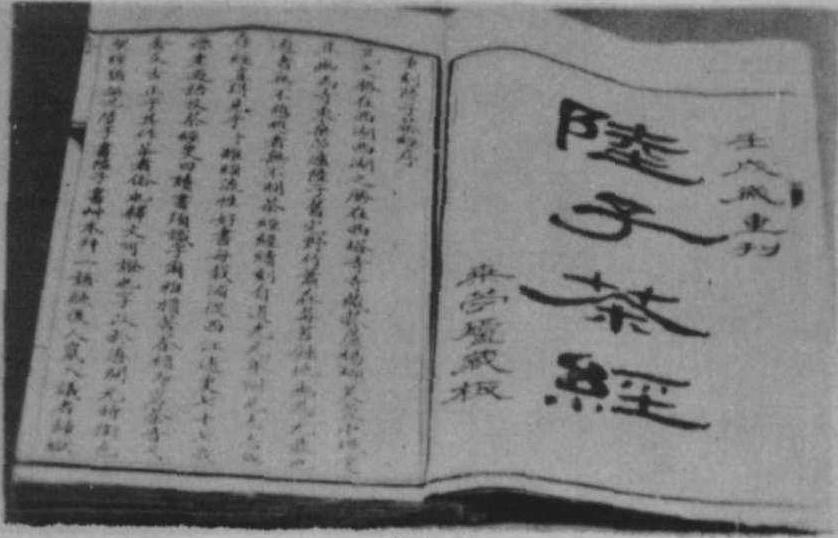《茶经》Tea Classics
唐代记述茶树栽培和茶叶加工方法的专著,也是世界上第一部茶学全书。作者陆羽(733~804),湖北竟陵(今天门)人。《茶经》系陆羽隐居浙江余杭苕溪所作,约成于760~765年间。《茶经》共三卷十篇,篇名用单词表达,顺次称作:“一之源”,考证茶的起源及性状;“二之具”,记载采茶、制茶的工具;“三之造”,记述茶叶种类和采制方法;“四之器”,记载煮茶、饮茶的器皿;“五之煮”,记载烹茶法及水质品位;“六之饮”,记载饮茶风俗和品茶法;“七之事”,汇辑有关茶叶的掌故及药效;“八之出”,列举茶叶产地及所产茶叶的优劣;“九之略”,指茶器的使用可因条件而异,不必拘泥;“十之图”,指将采茶、加工、饮茶的全过程绘在绢素上,悬于茶室,使得品茶时可以亲眼领略茶经之始终。《茶经》中提到巴山峡川有两人合抱的大茶树,是世界野生大茶树的最早记载,为茶叶起源于中国西南之说提供了又一证据。《茶经》反映当时人对茶叶的采摘时间、制作方法、鉴定标准、烹煮饮用方法都积累了丰富的经验。茶叶制作有采、蒸、捣、拍、焙、穿、封7个步骤,采制工艺已很细密。因原料及加工方法的不同,茶叶的外表不同,茶叶可分为8个等级。烹茶要选择水源。《茶经》反映了唐代茶叶生产的发达。书中列举了11个产茶省份,其中有名的茶区就有42处。在栽培技术方面,指出植茶“法如种瓜,三年可采”,表明当时一般都采用直播法,并注意用基肥。《茶经》在当时就已竞相传抄,风行全国,对饮茶之风的传播起了很大作用。《新唐书·隐逸传》说陆羽著《茶经》后“天下益知饮茶矣”。当时卖茶的人甚至将陆羽塑成陶像置于灶上,奉为茶神。《茶经》推动了唐以后茶叶的生产和茶文化的向海外传播,后人尊陆羽为“茶圣”。
《茶经》流传很广,有《百川学海》、《说郛》、《山居杂志》、《格致丛书》等近30种版本,还有日译本和英译本。1983年湖北人民出版社出版了傅树勤、欧阳勋的《陆羽茶经译注》。
《茶经》Tea Classics
中国第一部系统地阐述唐代和唐代以前有关茶叶的知识与生产实践经验的综合性古茶书。也是世界上论述茶叶的第一部专门著作。唐代陆羽撰。

《茶经》
《茶经》写作和完成初稿和修订刊行的时间, 约在唐代肃宗上元元年至德宗建中元年(760~780)。此书在《新唐书艺文志》小说类、《通志艺文略》食货类、《郡斋读书志》农家类、《直斋书录解题》农艺类、《宋史艺文志》农家类中,都有记载。《四库全书》著录刊本计26种, 通行的为宋《百川学海》本,明汪士贤刊本、《说郛》本3种。日本有《日本宝历》刊本、日本京都书肆天保十五年补刊本2种。美国有英译本1种。
《茶经》全书分为三卷十节:
卷上, “一之源”, 论茶树的形态特征、茶树的生物学特性, 茶名汇考及饮茶对人的保健功能等; 又说茶树植株大部分为灌木,在湖北省的巴东和四川省的东南部, 即现今大巴山的原始林区, 发现了躯干高大的茶树, 要砍下枝条才能把茶叶采下来。用类似茶树的树木形态作比拟, 论述茶树的外部形态, 指出宜茶的土壤、茶地方位、地形与鲜叶品质、品种与鲜叶品质关系及栽培方法,以及饮茶对人体的保健作用。“二之具”,介绍采茶和制茶的用具; 详述采制饼茶所需的工具15种, 将每种用具的名称、用材、大小规格及使用方法一一作了介绍。“三之造”,阐述茶叶采摘时间、要求、茶叶(主要是饼茶)的制法与品质的关系, 认为选取制茶原料, 要严格掌握采茶标准和时间, 提出以新梢长度、生长势作为采摘适度的标准。制饼茶的方法是: 蒸熟、捣碎入模拍压成形、焙干、穿成串、封装等六道工序。制成的产品有各种形状, 按外形的匀整和色泽, 可分为八个等级。
卷中, “四之器”一节, 详细阐述了30种煮茶和饮茶器具的名称、形状、用材、大小规格、制作方法等。其中: 升炉火用具4种, 煮茶用具3种, 烤、碾、量茶用具7种, 盛水、滤水和取水用具4种, 盛盐、取盐用具2种, 饮茶用具2种, 盛贮用具4种, 清洁用具4种。这些器具是陆羽设计制作的。饮茶用的碗是很讲究的。陆羽按照瓷色与茶色是否相调和来定各产地瓷器的优劣,说邢(今河北邢台)瓷白,盛茶呈红色;越(浙江绍兴)瓷青, 盛茶呈绿色, 因而断定“邢不如越。”又因洪州(今江西南昌)瓷褐色, 盛茶呈黑色, 定为最次品。陆羽以瓷色为主要标准评定瓷碗的优劣,只能是代表饮茶人的一种看法,但《茶经》中关于碗的一段话, 为我们提供了唐代瓷器生产的宝贵资料。
卷下, 包括: “五之煮”, “六之饮”, “七之事”,“八之出”, “九之略”,“十之图”六节。在“五之煮”一节中, 主要叙述煮茶的具体方法、饼茶烤炙、煮茶的燃料、用水和煮茶火候的掌握方法。着重论述茶汤显现有雪白而浓厚的泡沫是精英所在。在“六之饮”中,对当时一般的煮茶方法, 将茶放入瓶缶中,用开水冲灌,加进葱、姜等配料, 煮沸需很长时间, 煮好后把泡沫去掉。认为这种煮饮茶叶的方法,是不足取的。在“七之事”中,更从远古时代以迄唐代, 记载与茶相关的人物43人, 报道有关茶的传说、掌故、诗歌、杂文等48则, 主要内容有: 注释茶义, 称颂茶效,讲饮茶故事,记茶叶产地。另在“八之出”这一节中, 将唐代全国茶叶生产区域划分为: 山南、淮南、浙西、浙东、剑南、黔中、江西、岭南等八大茶区, 并将每一茶区出产的茶叶品质分为上、中、下、又下四级。“九之略”的一节,则是叙述至深山茶地采制茶叶,从事随采、随制、随饮, 可以简化为煮茶七种用具,以及制茶的七道工序。最后在“十之图”中说, 可把《茶经》所述内容写在洁白的绢上, 张挂在座位旁边, 就能随时看在眼里, 记在心上, 这样《茶经》从头到尾的内容就容易明白清楚。《茶经》总结了中国古代人民从事茶叶生产的经验, 提出种茶、制茶、评茶的理论和方法, 对中国古代茶叶生产的发展起过一定的推动作用。
《茶经》一书, 除唐代陆羽最早撰写以外,明代的徐渭(1575年前后)、张谦德(1596年)及黄钦(1635年前后)等三人均撰有《茶经》。清代陆廷灿1734年曾撰写《续茶经》三卷, 附录一卷。清代潘思齐撰有《续茶经》二十卷。此外,宋代周绛于1012年前后曾撰写《补茶经》一卷。明代孙大绶于1588年辑《茶经水辨》和《茶经外集》两书。
茶经
书名。唐代陆羽(733—804年)著。陆羽,字鸿渐,复州竞陵(今湖北天门县)人,于公元758年前后写成此书,分上、中、下三卷,共十节,约七千多字。上卷分三节:一之源,说明茶树的性状,茶叶的品质与土壤的关系。二之具,说明采制茶叶的各种工具。三之造,说明茶叶种类与采制方法。中卷:四之器,专门列举当时的烹茶和饮用器具。卷下:五之煮,说明烹茶技术。首先讲煮茶要避免香气散失,其次讲煮茶所用的燃料和水,以及煮沸程度和方法对茶汤色香味的影响。六之饮,谈饮茶起源和饮茶的风俗方式。七之事,述古代有关茶的故事、药方等。八之出,记述唐朝茶叶的产地和品质高低。九之略,全书的摘要,并指出在什么条件下大茶具茶器可以省略。十之图,把前九节写在素绢上,分四幅或六幅悬挂室内。此书已有日文译本,为我国现存最早的一本系统介绍茶的知识的专著,也是世界上著名的茶典。
茶经
古代茶叶专著。三卷。唐陆羽撰。陆羽(约733—约804),字鸿渐,一名疾,字季疵,自称桑苎翁,又号东冈子、竟陵子。复州竟陵(今湖北天门)人。上元初(760)隐居苕溪,闭门著书。征拜太子文学,又徙太常寺太祝,并未就职。一度曾为伶工。与女诗人李季兰、僧皎然等友好。能诗、嗜茶,曾漫游各处名山,考察各地茶树种类,研究烤焙茶叶的方法,后在浙江苍溪居住,经营茶园,并将自己所获的茶叶知识撰成《茶经》一书,遗泽后人。后世尊其为“茶祖”、“茶神”。
《茶经》共十篇。第一卷说明茶树的性状、品种、产地的一般知识;第二卷叙述茶叶的采摘、烤焙、储藏的各种方法;第三卷叙述烹茶所用的饮水、火候与茶杯的色彩等。陆羽总结了前人的经验,如茶叶采摘,他指出:“采不时,造不精,杂以卉莽,饮之成疾,茶为累也。”又如茶的加工,他说:“荆巴间采叶作饼,叶老者饼成,以米膏出之,欲煮茗饮,先炙令赤色,捣入瓷器中,以汤浇覆之,用葱、姜、桔子芼之,其饮醒酒,令人不眠。”这些都为中国茶叶史的研究提供了宝贵史料。
我国是茶树的原产地之一,也是世界上发现茶树和使用茶叶最早的国家,东晋时期已有饮茶之举。由于陆羽《茶经》的问世,至唐时,饮茶的风气已在全国盛行。《茶经》历代流传极广,对后世产生了深远影响。自宋以来,有关茶的著作不断问世,如宋代周绛的《补茶经》、熊蕃的《宣和北苑贡茶录》、黄儒的《茶品要录》、蔡襄的《茶录》,明许次纾的《茶疏》和清陆廷灿的《续茶经》等。
通行版本有《四库全书》本、《学津讨源》本、《百川学海》本和《唐宋丛书》本。
茶经
(唐)陆羽撰。3卷。分10目: 源(记生产与特性)、具(记采制用具)、造(记加工焙制)、器(记煎饮用器)、煮(记烹煮之法)、饮(记品尝性味)、事(引古书论茶之文)、出(记产地)、略、图。此书开后世茶书之先河。有《百川学海》、《格致丛书》本等。
茶经
书名。唐陆羽撰。中国第一部关于茶的专著。书中记载茶的性状、品质、产地、采制烹饮法及用具等。
《茶经》Tea Classics
唐代茶叶名著。世界上第一部茶叶专著。全书三卷,共7 000余字。卷上“一之源”,论茶的性状、名称和品质,“二之具”,讲采制茶叶的用具,“三之造”,论茶的种类和采制方法,卷中“四之器”,专讲茶的烹饮器具,卷下“五之煮”,论烹茶方法和水的品质,“六之饮”,讲饮茶习俗,“七之事”,汇述历史上茶的故事和记载,“八之出”,介绍全国有名的茶叶产地及所产茶叶品质,“九之略”,讲上述茶具、茶器中哪些可以省略,“十之图”是提倡把《茶经》抄在绢上张挂。《茶经》的问世,极大地促进了唐代茶业的发展,并把茶的知识提高为一门独立的学问,故《茶经》在国内外享有盛誉。除陆羽之外,明代徐谓、张谦德和黄钦分别所撰茶书,都取名《茶经》。
茶经
三卷。唐陆羽 (733—804)撰。陆羽,字鸿渐,一名疾,字季疵,自称桑苧翁,号东冈子,又号竟陵子,复州竟陵(今湖北天门县)人。上元初年隐居苕溪,诏拜太子文学,徙太常寺太祝,皆不就职。闭门著书,不时独行田野中,诵诗击木,痛苦而归。以嗜茶闻名,著有 《茶经》,旧时被人们奉为 “茶神”。《茶经》上卷,为茶之源、茶之具、茶之造三部分。茶之源,主要记述茶之产地、形状、优劣。茶之具,主要记述采茶、制茶的用具。茶之造,主要记述采茶、制茶的经过。中卷,为茶之器,主要记述煎茶、饮茶的用具。下卷,主要记述茶之煮、茶之饮、茶之事、茶之出、茶之略、茶之图。全书十类,其文实九,所谓图,是指统上九类,书于绢素,张挂起来,非另有图。是书言茶十分精备,文字古朴典雅,可资后世借鉴考证。现存《百川学海》本、《说郛》本、明刊一卷本、明刊吕氏十种本、《唐宋丛书》本、《学津讨原》本、《格致丛书》本、汪士贤刊本、《百名家书》本、清钞本、《唐人说荟》本、《四库全书》本、《湖北先正遗书》本、1983年湖北人民出版社出版傅树勤、欧阳勋 《陆羽茶经译注》等。
《茶经》
中国第1部茶叶专著。作者唐代陆羽(733~804)。约成书于780年。全书分3卷10节,7000多字。卷上,“一之源”叙述茶的一般特性;“二之具”,介绍了采茶和制茶的用具,叙述了采制饼茶的15种工具;“三之造”叙述了茶的加工和种类。卷中为“四之器”,介绍了30种茶具。卷下包括“五之煮”、“六之饮”、“七之事”、“八之出”、“九之略”、“十之图”6节。